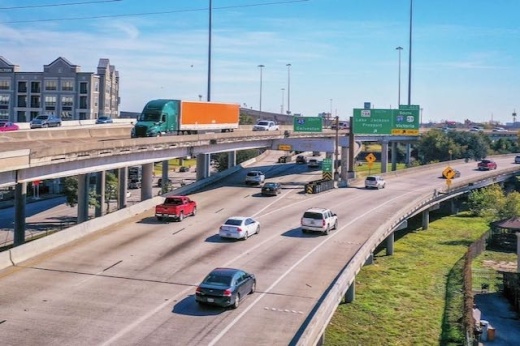The project has been described as transformational by its supports, while also generating controversy among opponents who question how much it will relieve congestion, and criticize the planned displacement of hundreds of households and businesses, largely affecting communities of color in the project's footprint.
Two-minute impact
The I-45 expansion, formerly referred to as the North Houston Highway Improvement Project, has been under development by TxDOT since 2002. Its core components include adding four managed lanes on I-45 from Downtown Houston to Beltway 8 North as well as rerouting I-45 to be parallel with I-10 on the north side of downtown and parallel with I-69 on the east side of downtown, according to TxDOT information.
Other elements include bicycle and pedestrian features along frontage roads and cross streets, and new trails parallel to bayous.
The backstory
TxDOT issued a record of decision on the project in 2021, clearing the way for construction to move forward with an estimated cost of $9 billion at the time.
In 2021, the Federal Highway Administration opened an investigation into the project and potential violations of the Civil Rights Act related to its disproportionate effect on communities of color. The project was put on hold while the investigation played out, and TxDOT and the FHWA reached an agreement in 2023.
Under the Voluntary Resolution Agreement, TxDOT promised to, among other efforts, put an additional $30 million toward helping displaced residents relocate, and to look for additional ways to reduce the project footprint "that would not compromise the integrity and functionality of the purpose and need of the project."
At an Oct. 16 ground breaking event, Texas Transportation Commissioner Bruce Bugg said the overall cost has risen to around $13 billion. The three segments of the project are not slated for completion until around 2038.
Digging in
The full project has been separated into three segments, with work on Segment 3—which involves reconstructing portions of I-10, I-45, I-69, and SH 288 around downtown Houston—starting first.
According to TxDOT, the project will:
- Add $29 billion in savings from improving road safety and reliability
- Generate $3 billion in benefits due to less idling and improved air
- Generate $10 billion in business benefits and more the 90,000 new jobs
- Pull 1,309 acre-feet of stormwater off Houston roads through flood mitigation elements
The I-45 expansion will also involve making safety improvements, TxDOT officials said, including adding full-width shoulders, better sight lines, and safer entrance and exit ramps.
What they're saying
At the Oct. 16 event, Bugg said the main driver of the project was population growth in Houston.
Population in The Woodlands-Houston-Pasadena metropolitan area is around 7.3 million, according to the Greater Houston Partnership, an economic development group that has come out in support of the NHHIP. That population is expected to grow to 10 million by 2050, Bugg said.
Houston Mayor John Whitmire also trumpeted the project's economic impact at the event, noting that it would improve mobility between Houston's port, medical center, sports venues and retail areas.
"This road is about economic development," said Steve Alvis, a member of the Texas Transportation Commission, at the Oct. 16 event.
Another perspective
Volunteers with Stop TxDOT I-45—an advocacy group formed with the goal of getting TxDOT to change the project in ways that reduce displacements and other negative effects—protested at the Oct. 16 ground breaking.
Erin Eriksen, an organizer with Stop TxDOT I-45, said the VRA did not address the group's concerns related to displacements, and said she was also concerned the wider highway would increase risks for asthma and other lung diseases for people who end up living closer to the freeway.
"One of the things is really looking at the footprint and where they can decrease the footprint," she said. "We should not be in the business of displacing anyone anymore for a project. Figure out a different solution."
Eriksen also questioned how much the project would ultimately help with congestion, citing "induced demand"—the idea that road improvements to relieve congestion also bring more drivers to the roadway, offsetting benefits.
Opponents have pointed to the 2011 expansion of I-10 in Houston to 23 lanes as what they say will happen with the NHHIP. By 2014, commute times on I-10 were worse than they were before the expansion, according to traffic data from Houston TransStar.
What's next
Work on Project 3B-1 will carry on through late 2027. A separate contract will be awarded for landscaping, and TxDOT officials said they will coordinate with stakeholders on a final landscape design. Work on the $496 million Project 3B-2 will begin in 2025, which involves depressing main lanes, building arch bridges and creating a pedestrian realm in the area where I-45 splits off to Hwy. 288.
Elsewhere, TxDOT officials said they will continue to look for opportunities to decrease the project's footprint as part of the design process.
The right of way acquisition process is still underway, with TxDOT seeking to acquire a number of properties within Segment 3, including along I-69 between Hwy. 288 and Main Street, and along I-10 between I-45 and I-69.





